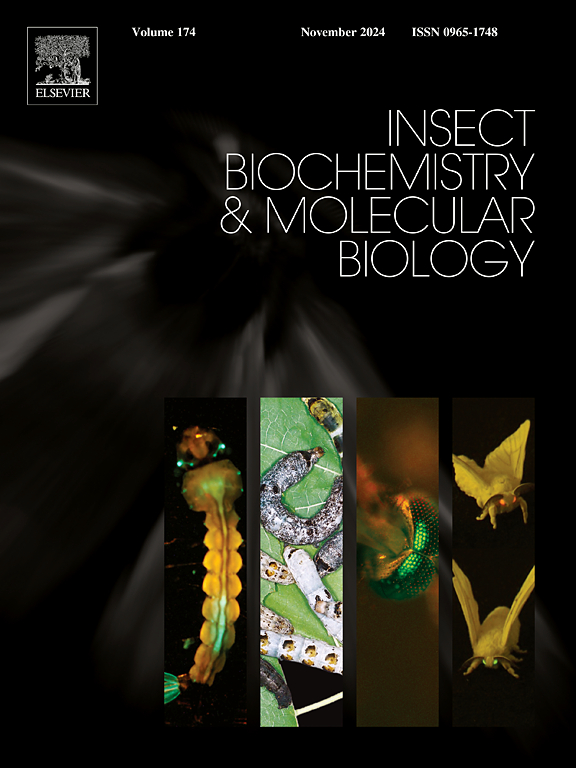嗜电性受体参与小菜蛾成虫对紫红素的感知
IF 3.7
2区 农林科学
Q2 BIOCHEMISTRY & MOLECULAR BIOLOGY
引用次数: 0
摘要
硫代葡萄糖苷是十字花科植物专家选择寄主植物的关键味觉线索,然而,这种味觉的分子机制尚不清楚。在这里,我们证明了两个嗜离子受体共受体(Ircos)参与了小菜蛾成虫对主要硫代葡萄糖苷(sinigrin)的感知。首先,我们克隆了13个味觉受体(GRs)在成年爪蟾(触角和跗趾)和幼虫(头部)中表达,并利用爪蟾卵母细胞表达系统分析了它们的功能。结果表明,这些GRs对sinigin没有反应。然后,我们转向嗜离子受体(IRs),特别是两个Ircos (PxylIR25a和PxylIR76b),首先使用CRISPR-Cas9方法建立了两个单Irco敲除和一个双Ircos敲除的昆虫菌株。进一步的行为分析显示,敲除这两个Ircos(无论是单敲还是双敲)都显著降低了雌性成虫对紫红素的感知,三种敲除菌株之间没有差异,这表明这两个Ircos参与了紫红素感知的合作。然而,在三种敲除菌株中,幼虫对紫荆素的摄食偏好总体上未受影响。这些结果表明,小菜蛾成虫至少部分通过ir介导的途径感知紫红素,而幼虫则通过其他途径感知紫红素。我们的发现为研究芥子油苷的味觉机制提供了新的见解,并为开发新的控制策略提供了潜在的分子靶点。本文章由计算机程序翻译,如有差异,请以英文原文为准。

Ionotropic receptors participate in the perception of sinigrin in Plutella xylostella adults
Glucosinolates serve as the key gustatory cue for crucifer specialists to select their host plants, however, the molecular mechanisms underlying the gustation remain poorly understood. Here, we demonstrated that two ionotropic receptor co-receptors (Ircos) were involved in the perception of a major glucosinolate, sinigrin, in the adult Plutella xylostella. First, we cloned 13 gustatory receptors (GRs) expressed in adults (antennae and tarsi) and larvae (heads), and analyzed their functions using the Xenopus oocyte expression system. It showed that none of these GRs responded to sinigrin. Then we turned to ionotropic receptors (IRs), particularly the two Ircos (PxylIR25a and PxylIR76b), starting with establishment of two single Irco knockout and one double Ircos knockout insect strains using CRISPR-Cas9 approach. Further behavioral assays revealed that knockout of these two Ircos (in both single and double knockout) significantly reduced the sinigrin perception in female adults with no difference among the three knockout strains, suggesting that the two IRs participate in collaboration in the sinigrin perception. However, larval feeding preference for the sinigrin remained generally unaffected in the three knockout strains. These results demonstrate that adult P. xylostella perceive sinigrin at least partly through IR-mediated pathway, but the larvae employ other pathways. Our findings provide new insights into the gustatory mechanisms of glucosinolates, and provide potential molecular targets for development of new control strategies in P. xylostella and other crucifer specialists.
求助全文
通过发布文献求助,成功后即可免费获取论文全文。
去求助
来源期刊
CiteScore
7.40
自引率
5.30%
发文量
105
审稿时长
40 days
期刊介绍:
This international journal publishes original contributions and mini-reviews in the fields of insect biochemistry and insect molecular biology. Main areas of interest are neurochemistry, hormone and pheromone biochemistry, enzymes and metabolism, hormone action and gene regulation, gene characterization and structure, pharmacology, immunology and cell and tissue culture. Papers on the biochemistry and molecular biology of other groups of arthropods are published if of general interest to the readership. Technique papers will be considered for publication if they significantly advance the field of insect biochemistry and molecular biology in the opinion of the Editors and Editorial Board.

 求助内容:
求助内容: 应助结果提醒方式:
应助结果提醒方式:


